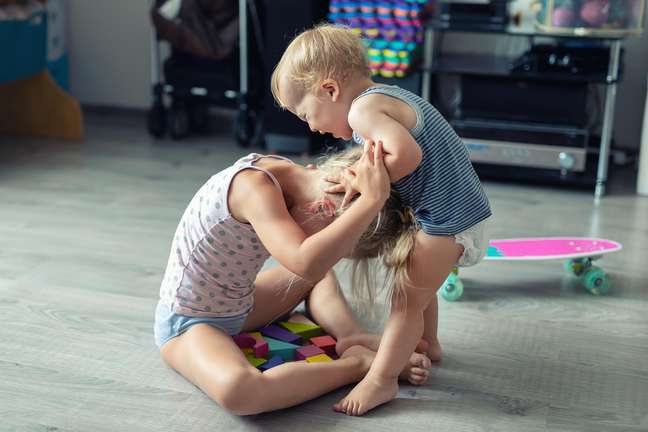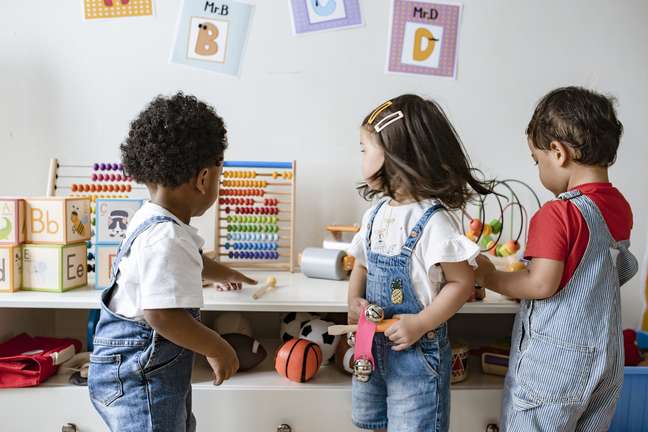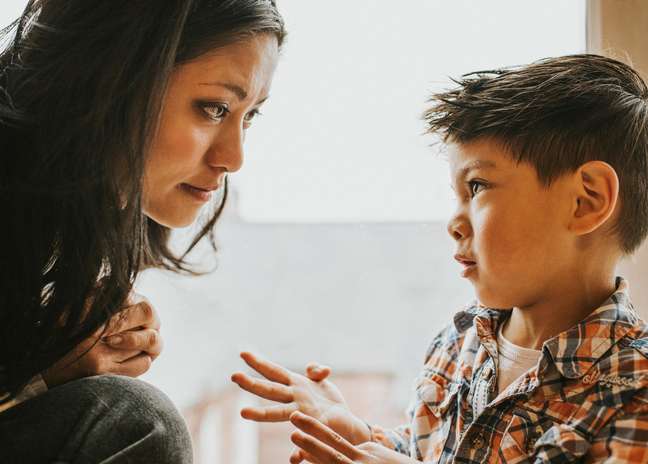Pushing, slapping, biting and pinching are all forms of communication for young children. But there are ways to teach her to express herself in another way.
Until the child learns to communicate orally, situations involving biting and aggression may occur more frequently. It is natural for some little ones to slap, push, kick or bite the people around them.. “These are their first dialogues with the world. In this way, the child wants to communicate something,” explains Ana Paula Detzel, early childhood education coordinator at Colégio Marista Santa Maria.

The intensity of the behavior will depend on the maturity of the child. For a child up to two years old, this type of attitude is more common. After all, he can’t speak or even realize what he’s feeling, let alone express it. By the age of three or four, your little one is expected to begin communicating through speech., body and facial expressions, instead of focusing on aggression. “This is an age when she should stop biting or hitting others,” says Danielle Admoni, general child and adolescent psychiatrist and specialist for the Brazilian Association of Psychiatry (ABP).
Do bites and shoves have to do with anger and aggression?
In a certain way, yes. But this behavior doesn’t just indicate anger. “Sometimes, the child is upset, he doesn’t like a situation or someone takes something away from him. He will be upset and, as he is very immature, this is the way he finds to deal with the occasion,” explains the psychiatrist. The little one may also experience euphoria or a need to show affection. Since he cannot express himself in any other way, he ends up reacting in a way that is socially considered aggressive.
“We have to remember that the sensory and physical development (such as teething) of babies occurs in the first few years of life. With this, we realize that Biting, pushing and pinching are resources to demonstrate discontent, frustration or physiological need“, adds Ana Paula.
conflict situations
It is in the child’s first experiences of social life that aggressive attitudes can manifest themselves. Toy disputes or adult attention are some examples. It is common for conflicts or frustrations to arise through interaction between children of the same age.
“Very young children are in full cognitive, social, emotional, sensory, motor maturation. Everything around them is new and they are expected to explore and investigate new things. This interaction also occurs through the oral region. Therefore, they bring everything to their mouths and biting is part of the process,” he explains.

–
The role of the adult
In the face of aggressive behavior, the adult’s role is to be the child’s spokesperson. “For the little one, these attitudes are learning. She behaves like this because she has not yet learned to use other resources. It is up to the parents to guide, talk and reinforce that we do not relate to hitting, attacking or biting,” guides Ana Paula.
The adult is responsible for doing what the child cannot do. Name the feelings the child is unable to express and what could be done differently. “Always get down to the child to talk to him. Look him in the eyes and talk to him calmly, without yelling, hitting or ‘going crazy’. Name the situation and point out the results of the child’s attitudes. It is important that he sees what he has caused in the other, without fighting.“says Daniel.
Welcoming and guiding your child to apologize is a lesson for both children involved in the situation. Apologies have an opportunity to rethink their attitudes and look for other ways to show their discontent. The one who receives the forgiveness request will also learn that everyone is prone to mistakes and situations can be corrected. ” The adult must encourage the child to create a repertoire so that he can demonstrate his feelings and emotions. Dialogue is essential”, explains the coordinator.
How to talk to children from 1 to 3 years
“This age group needs clarity and consistency,” says Ana Paula. The adult should indicate guidelines and rules, explaining that hitting and hurting is not allowed. Engravings, images and symbols that indicate good resolution possibilities are also effective. “For example, photos of children hugging, walking hand in hand or talking. Always with ‘positive action messages’ so that this is reinforced,” she points out.
How to talk to children aged 3 to 6
Slightly older children follow the same requirements. With them, you can create lists of what are rules and combined. It is also interesting to use children’s stories and literature books frequently. “You can make guides, posters and notebooks with ideas for solutions to conflicts and leave them for the children to look for and use whenever they want,” explains Ana Paula.

The role of the school
It is at school that most children begin to socialize and the institution must be a partner in the family. That is, keeping the communication channel open, describing the behaviors presented and suggesting possible solutions.
In addition, the conflict judges will be teachers and assistants. It is important that professionals are able to help the child deal with the situation, follow the dialogues and provide her with a space to express her collective and individual emotions. “She needs to feel that she can speak, be heard and respected. The ’emotionometers’ and other elements allow her to express how she feels,” says Ana Paula.
Encourage the child to express their emotions
Aggressive situations among young children are considered natural in development, but they cannot be ignored and require constant monitoring and guidance. “To learn to express their emotions, the little one needs a safe home, where his needs are met,” says Danielle.
This does not mean that your child will be able to do whatever he wants, but who needs to feel confident and calm to develop. Knowing he can count on his parents, who will guide him, look after him and welcome him. “Dialogue, exchange, argument and counter-argument are skills to be developed throughout life,” recalls Ana Paula.
Although, if the behaviors are repeated frequently even after mediations, more attention is required. In these cases, families are advised to seek specialized help to care for the child.
+The best content in your email for free. Choose your favorite Terra newsletter. Click here!
Source: Terra
Ben Stock is a lifestyle journalist and author at Gossipify. He writes about topics such as health, wellness, travel, food and home decor. He provides practical advice and inspiration to improve well-being, keeps readers up to date with latest lifestyle news and trends, known for his engaging writing style, in-depth analysis and unique perspectives.







